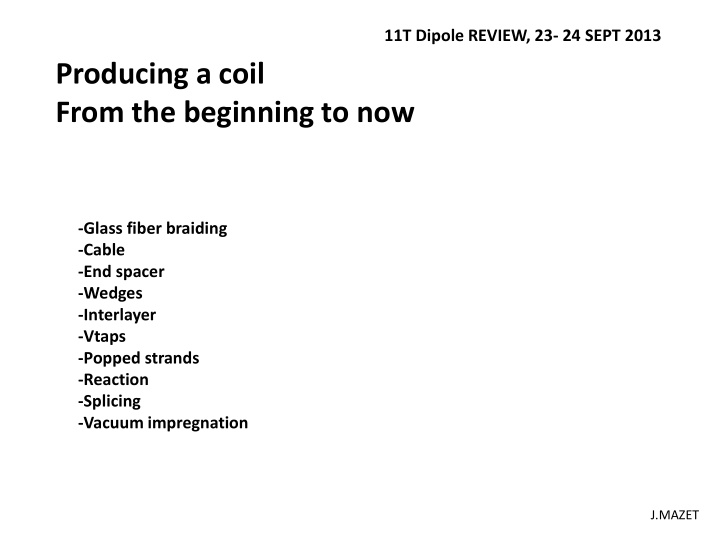



11T Dipole REVIEW, 23- 24 SEPT 2013 Producing a coil From the beginning to now -Glass fiber braiding -Cable -End spacer -Wedges -Interlayer -Vtaps -Popped strands -Reaction -Splicing -Vacuum impregnation J.MAZET
Summary of manufacture
Braiding 11TEX +MICA cable Nb3Sn 11T Dipole
Cable Cu, WST (ITER), RRP-54/61 Stable cable Winding 3 days/layer Winding tension 30 kg
Discovery of a popped strand Câble RRP-108/127 in the internal winding radius Cable unstable after unwinding. Winding 6 days/layer Winding tension 20 Kg Temporary solution: -Bond fiber glass whith ceramic binder. -Use a special tool. Disadvantage: Difficult to control. Curred binder stiffens cable.
End spacers End spacer in one part Implementation difficult. Damages the cable insulation . Modification of the spacer geometry necessary.(!)
End spacer with springy leg Implementation easy. Minimize deterioration of cable insulation .
Electrical insulation of spacers Tapes of Sglass 16 mm*0.15 mm insulating the spacer from the cable . Disadvantage: No certainty to cover the total surface of the spacer in contact with the cable. During clamping /de clamping of the coil , the leg of the spacer moves (rotates) and may damage the insulation of the cable . Risque de CC.
Electrical Insulation of Spacers Alternative: Coating with vitreous enamel Good mechanical properties at 77K Maximum operating temperature ≥ 750 °C Radiation resistant.
Insulation of wedges The extremities of the fibreglass sleeving is glued with ceramic binder. The mechanical behaviour of this gluing does not allow the correct insulation of the extremity of the wedge. Risk of shorts.
INNER LAYER Filling of the gaps over the coil blocks in the heads, by means of a ceramic liquid mixed with cruched fibres, before installing the inter layer. Inter layer 2 layers of fibreglass (S glass). Total thickness: 0.5mm
Inter layer with quench heater Thickness 0.7mm High voltage resistance measurement > 8G Ω Trials inside the coil #103 (WST) was not successful due to a problem with the thickness of the cable Insulation (oversized)
VTAPS Installing Vtaps during coil winding is possible on the outer layer. On the inner layer, there is a risk to pinch the vtaps between 2 turns due to the clamping/declamping of the coil turns during the winding. For our coils to be instrumented, the voltage taps will be basd on the FNAL technique: soldering after coil impregnation
Coil Nb3Sn 108/127 After curing The springy legs of the spacers have moved in correct position and are well aligned Note: no gap filling with ceramic putty on top of the coil blocks for the coil outer layer
Popped strand on Coil 108/127 #002
Repair of Popped strand on Coil 108/127 #002
Reaction Cutting of the ‘’core ‘’ Reaction poles are aligned by means of keys and Pinned to the mandrels. Closing the tool and preparation of the strand samples (VAMAS). Piping for the circulation of Argon gaz inside the tool.
After reaction
Splicing Splicing procedure Nb-Ti busbar is pre-tinned Top surface of the Nb3Sn cable is cleaned Soldering of the Nb3Sn/Nb Ti junction ‘’C’’ -shape wrapping of kapton for insulation Disadvantage: No control of the migration of the Tin solder through the Nb3Sn cable (Bonding of the bottom strands hazardous)
Risk of short The flux sticks to the tooling baseplate, and pull the splice when the baseplate is removed The flux migrates by capillarity inside the fibreglass and pollutes locally the impregnation
Transfert Reaction Tooling Impregnation tooling Filling all gaps Installing fibreglass cloth Installing the loading plates Aligning the impregnation poles with keys
Installing the top part of the impregnation tooling Preparation for the rotation of the tooling
Closing the extremities of the tooling Vacuuming the tooling to test tightness
Polymerisation
Recommend
More recommend